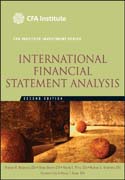
International financial statement analysis
Robinson, Thomas R.
Henry, Elaine
Pirie, Wendy L.
Broihahn, Michael A.
Up-to-date information on using financial statement analysis to successfully assess company performance, from the seasoned experts at the CFA InstituteDesigned to help investment professionals and students effectively evaluate financial statements in today's international and volatile markets, amid an uncertain global economic climate, International Financial Statement Analysis, Second Edition compiles unparalleled wisdom from the CFA in one comprehensive volume.Written by a distinguished team of authors and experienced contributors, the book provides complete coverage of the key financial field of statement analysis. Fully updated with new standards and methods for a post crisis world, this Second Edition covers the mechanics of the accounting process; the foundation for financial reporting; the differences and similarities in income statements, balance sheets, and cash flow statements around the world; examines the implications for securities valuation of any financial statement element or transaction, and shows how different financial statement analysis techniques can provide valuable clues into a company's operations and risk characteristics.Financial statement analysis allows for realistic valuations of investment, lending, or merger and acquisition opportunitiesEssential reading for financial analysts, investment analysts, portfolio managers, asset allocators, graduate students, and others interested in this important field of financeIncludes key coverage of income tax accounting and reporting, the difficulty of measuring the value of employee compensation, and the impact of foreign exchange rates on thefinancial statements of multinational corporationsFinancial statement analysis gives investment professionals important insights into the true financial condition of a company, and International Financial Statement Analysis, Second Edition puts the full knowledge of the CFA at your fingertips. INDICE: ForewordPrefaceAcknowledgmentsIntroductionChapter 1 Financial Statement Analysis: An IntroductionLearning Outcomes1 Introduction2 Scope of Financial Statement Analysis3 Major Financial Statements and Other Information Sources4 Financial Statement Analysis Framework5 SummaryProblemsChapter 2 Financial Reporting MechanicsLearning Outcomes1 Introduction2 The Classification of Business Activities3 Accounts and Financial Statements4 The Accounting Process5 Accruals and Valuation Adjustments6 Accounting Systems7 Using Financial Statements in Security Analysis8 SummaryAppendix 2A: A Debit/Credit Accounting SystemProblemsChapter 3 Financial Reporting StandardsLearning Outcomes1 Introduction2 The Objective of Financial Reporting3 Standard-Setting Bodies and Regulatory Authorities4 Convergence of Global Financial Reporting Standards5 The International Financial Reporting Standards Framework6 Effective Financial Reporting7 Comparison of IFRS with Alternative Reporting Systems8 Monitoring Developments in Financial Reporting Standards9 SummaryProblemsChapter 4 Understanding Income StatementsLearning Outcomes1 Introduction2 Components and Format of the Income Statement3 Revenue Recognition4 Expense Recognition5 Non-Recurring Itemsand Non-Operating Items6 Earnings per Share7 Analysis of the Income Statement8 Comprehensive Income9 SummaryProblemsChapter 5 Understanding Balance SheetsLearning Outcomes1 Introduction2 Components and Format of the Balance Sheet3 Current Assets and Current Liabilities4 Non-Current Assets5 Non-Current Liabilities6 Equity7 Analysis of the Balance Sheet8 SummaryProblemsChapter 6 Understanding Cash Flow StatementsLearning Outcomes1 Introduction2 Components and Format of the Cash Flow Statement3 The Cash Flow Statement: Linkages and Preparation4 Cash Flow Statement Analysis5 SummaryReferencesProblemsChapter 7 Financial Analysis TechniquesLearning Outcomes1 Introduction2 The Financial Analysis Process3 Analytical Tools and Techniques4 Common Ratios Used in Financial Analysis5 Equity Analysis6 Credit Analysis7 Business and Geographic Segments8 Model Building and Forecasting9 SummaryReferencesProblemsChapter 8 Financial Statement Analysis: ApplicationsLearning Outcomes1 Introduction2 Application: Evaluating Past Financial Performance3 Application: Projecting Future Financial Performance4 Application: Assessing Credit Risk5 Application: Screening for Potential Equity Investments6 Analyst Adjustments to Reported Financials7 SummaryReferencesProblemsChapter 9 InventoriesLearning Outcomes1 Introduction2 Cost of Inventories3 Inventory Valuation Methods4 The LIFO Method5 Inventory Method Changes6 Inventory Adjustments7 Evaluation of Inventory Management8 SummaryProblemsChapter 10 Long-Lived AssetsLearning Outcomes1 Introduction2 Acquisition of Long-Lived Assets3 Depreciation and Amortisation of Long-Lived Assets4 The Revaluation Model5 Impairment of Assets6 Derecognition7 Presentation and Disclosures8 Investment Property9 LeasingSummaryProblemsChapter 11 Income TaxesLearning Outcomes1 Introduction2 Differences between Accounting Profit and Taxable Income3 Determining the Tax Base of Assets and Liabilities4 Temporary and Permanent Differences between Taxable and Accounting Profit5 Unused Tax Losses and TaxCredits6 Recognition and Measurement of Current and Deferred Tax7 Presentation and Disclosure8 Comparison of IFRS and U.S. GAAPSummaryProblemsChapter 12 Non-Current (Long-Term) LiabilitiesLearning Outcomes1 Introduction2 Bonds Payable3 Leases4 Introduction to Pensions and Other Post-Employment Benefits5 Evaluating Solvency: Leverage and Coverage Ratios6 SummaryProblemsChapter 13 Employee Compensation: Post-Employment and Share-BasedLearning Outcomes1 Introduction2 Pensions and Other Post-Employment Benefits3 Share-Based Compensation4 SummaryReferencesProblemsChapter 14 Intercorporate InvestmentsLearning Outcomes1 Introduction2 Basic Corporate Investment Categories3 Investments in Financial Assets4 Investments in Associates5 Joint Ventures6 Business Combinations7 Variable Interest and Special Purpose EntitiesSummaryProblemsChapter 15 Multinational OperationsLearning Outcomes1 Introduction2 Foreign Currency Transactions3 Translation of Foreign Currency Financial StatementsSummaryProblemsChapter 16 Evaluating Financial Reporting QualityLearning Outcomes1 Introduction2 Discretion in Accounting Systems3 Financial Reporting Quality: Definitions, Issues, andAggregate Measures4 A Framework for Identifying Low-Quality Financial Reporting5 The Implications of Fair Value Reporting for Financial Reporting Quality: A Brief DiscussionSummaryProblemsChapter 17 Integration of Financial StatementAnalysis TechniquesLearning Outcomes1 Introduction2 Case Study 1: Long-term equity investment3 Case Study 2: Off-Balance Sheet Leverage From Operating Leases4 Case Study 3: Anticipating Effects Of Changes in Accounting Standards5 ConclusionProblemsGlossaryReferencesAbout the AuthorsAbout the CFA ProgramIndex
- ISBN: 978-0-470-91662-9
- Editorial: John Wiley & Sons
- Encuadernacion: Cartoné
- Páginas: 1040
- Fecha Publicación: 16/05/2012
- Nº Volúmenes: 1
- Idioma: Inglés
